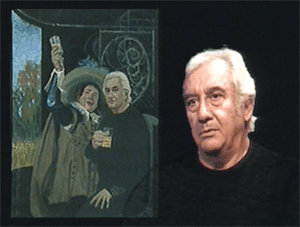Herman Braun-Vega facts for kids
Quick facts for kids
Herman Braun-Vega
|
|
|---|---|
 |
|
| Born | 7 July 1933 |
| Died | 2 April 2019 (aged 85) |
| Nationality | Peruvian |
| Known for | Painting |
Herman Braun-Vega (born July 7, 1933, in Lima, Peru – died April 2, 2019, in Paris, France) was a famous Peruvian painter. He was known for his unique style.
At first, his paintings looked almost abstract, meaning they didn't show clear objects. But after 1970, his art changed a lot. This happened when he moved to Paris in 1968. There, he saw many artworks by great masters. He started to use parts of famous paintings in his own work. This is called "pictorial quotation."
Braun-Vega wanted his art to be easy for everyone to understand. Even though his paintings often had deep meanings, they looked clear. His art often showed people, landscapes, and fruits from his home country, Peru. He mixed his Peruvian background with European art history. His colorful paintings sometimes included political messages. He often added newspaper clippings to his art. He saw himself as someone who showed what was happening in his time. His art aimed to make people think and remember. His style is part of movements called New Figuration and Narrative Figuration. These styles focus on telling stories or showing real-life scenes.
Contents
About His Life
His Family
Herman Braun-Vega's father, Francisco Braun Weisbrod, was Jewish. He was born in 1902 in a city that is now in Hungary. His mother, Armida Vega Noriega, was from Iquitos, a city in the Peruvian Amazon.
Herman was born in Lima. He had an older brother, Max, who also became a painter. After Herman, three more siblings were born: Berti, Álex, and Aurora. They also became artists or designers.
His father loved art and bought copies of famous paintings from Paris. He had them framed in Peru. This made Max want to become a painter first. Herman wanted to follow in his brother's footsteps.
His Education
In 1950, Herman started studying at the School of Fine Arts in Lima. He studied there for about a year and a half. In 1951, his brother Max, who was 19, moved to Paris to become a painter. Later that year, Herman, at just 18, also moved to Paris.
In Paris, he finally saw original artworks by great masters. Before, he had only seen pictures of them. From then on, he taught himself by studying art in museums. He also learned from other artists.
Life in Lima and Paris
In 1955, Herman returned to Lima, Peru. He started a design business there. But soon, he felt the strong need to paint again. In Lima, he met Nicole Boussel. He formed a family with her and her two sons, along with his own son. This family often appeared in his paintings during the mid-1960s.
A Peruvian Artist in Paris
In 1967, Herman moved back to Paris with his son. He met Lisbeth Schaudinn, who became his wife and model. In 1968, they visited the Picasso Museum in Barcelona. There, he saw Picasso's paintings inspired by Velázquez's famous "Las Meninas." This was a huge moment for his art.
Lisbeth helped Herman focus completely on his painting. Even though he lived in Paris, he often visited Peru. The Peruvian newspapers wrote about his success in Paris. He had art shows in Paris, Lima, New York, and Brussels. In the 1970s, he developed new ways of painting and new topics for his art. He traveled a lot and even built a house in Peru. From the 1980s, his art showed his life, which was a mix of European culture and his Latin American roots.
His Artworks
In 1978, Herman Braun-Vega began painting portraits. He often painted his artist friends. He invited them to be part of the painting process. Some of the artists he painted include Vladimir Veličković, Erró, and Wifredo Lam. He also painted many writers like Jorge Semprún and Julio Ramón Ribeyro.
His art mixes different cultures, ideas, and backgrounds. It aims to make the viewer remember things. This includes historical memories from famous Western paintings. It also includes social and political memories from current events. He often added real-life situations to his art.
The sociologist Zygmunt Bauman called Herman Braun-Vega one of the best examples of "liquid art." This means art that is always changing and flowing, like modern life.
See also
 In Spanish: Herman Braun-Vega para niños
In Spanish: Herman Braun-Vega para niños

